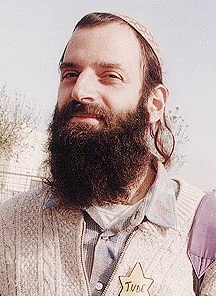 |
| Baruch Goldstein |
In celebrating Purim this weekend, we should not forget a disastrous event that cascaded into even greater catastrophes in its wake. The first seriously bad incident during the Oslo peace process occurred on Purim, February 25, 1994. Baruch Goldstein, a medical doctor and West Bank settler, murdered 29 Palestinians and wounded 125 at prayer in Hebron, spraying them with his army-issued machine gun (he was a reservist), before he was overwhelmed and beaten to death.
Goldstein was an American disciple of the right-wing extremist Meir Kahane. A religiously-observant Jew, he was undoubtedly inspired by the Purim story to enact his personal drama of violent retribution against those he perceived as enemies of the Jews, as described at the end of the Megillat Ester. (As an extreme right-wing source claims, he may well have believed that he was forestalling an attack on his community.)
Shulamit Aloni and other leading figures in Meretz (Yitzhak Rabin’s main coalition partner) argued for forcibly removing the extremist settlers from Hebron and/or nearby Kiryat Arba — where Goldstein lived. We don’t know if such a resolute act of contrition would have changed history by allaying Palestinian anger, but it might have, while also removing the most militant of settler communities when most Israelis would have supported such a move. Instead, Rabin decided to stay rigidly within the gradual Oslo timetable for negotiating the future of the settlements as a final status issue.
If not for Goldstein, we can only speculate on how much (or how little) terrorism would have occurred during the Oslo years. A History Channel documentary on Palestinian terrorism claimed that Yiyah Ayyash, the master Hamas bomb-maker known as “the engineer,” became a terrorist as a personal reaction to the Goldstein massacre in Hebron. Ayyash was responsible for the deaths and injuries of scores of Israelis in ‘94 and ‘95.
The sequence of untoward events, arguably triggered by Goldstein, goes even further. Early in January 1996, Israel’s General Security Service located Ayyash, and Prime Minister Peres okayed killing him with an exploding cell phone. Tragically, Hamas and Islamic Jihad struck back with a wave of terror attacks in late February and early March. Three were devastating — two on the same bus line in Jerusalem and one at a mall in Tel Aviv (killing numerous children in costume for Purim). All in all, about 60 Israeli civilians were murdered with many more injured.
This being the middle of the election campaign, Peres immediately lost his 20-point lead in the polls over Bibi Netanyahu, eventually to lose by a hair. With this lost election, the peace process was effectively decapitated, as Israel was no longer led by a prime minister who believed in it.




Leave A Comment